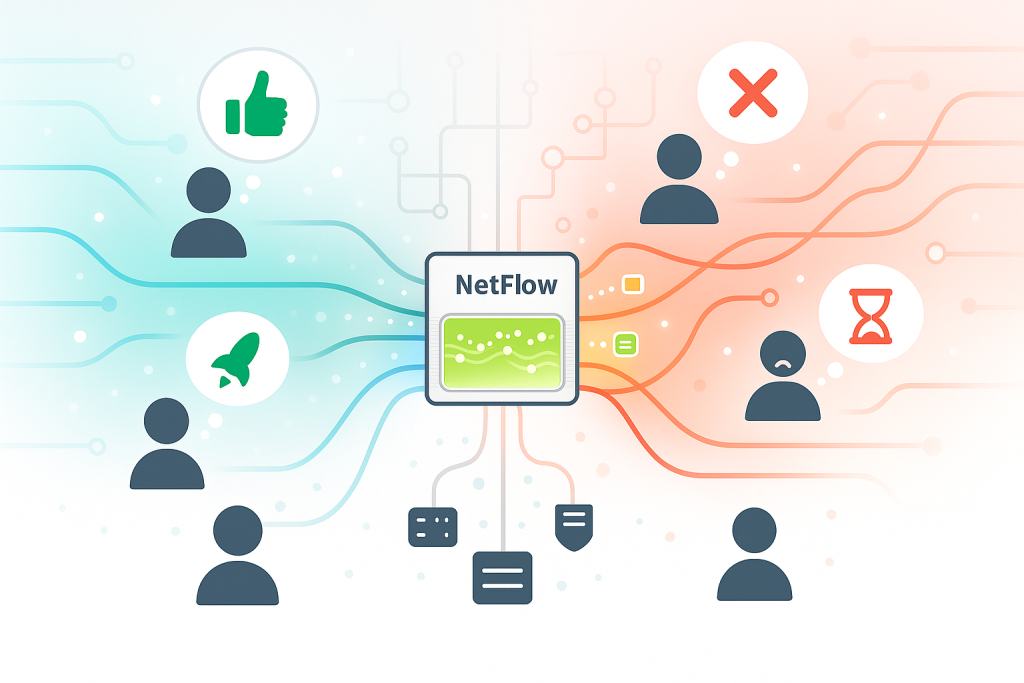In the modern enterprise, the network is not just a utility; it’s the environment in which every employee works, communicates, and collaborates. Because of this, the line between network performance and employee experience (EX) has completely blurred.

When the network lags, the employee experience suffers. When an application crawls, productivity grinds to a halt. For IT and security teams, the challenge is clear: how do you monitor user activity to maintain security and ensure compliance without sacrificing the high-quality, seamless experience your employees expect?
The answer lies in moving beyond raw network data and embracing Optimized and Enriched NetFlow. By focusing on the human context behind every data flow, NetFlow transforms from a purely technical tool into a strategic asset that simultaneously improves security and IT support.
The Dual Challenge: Security vs. Experience
Traditional User Activity Monitoring (UAM) often focuses only on the negative—tracking file access, flagging policy violations, or monitoring insider threats. While essential for security, this approach can feel invasive and rarely helps improve the user’s day-to-day work life.
On the flip side, IT support often struggles with vague user complaints: “The application is slow,” or “The network is broken.” They lack the granular, contextual data to diagnose the problem quickly, leading to long resolution times and user frustration.
Optimized NetFlow solves both problems by providing a unified, objective view of network activity tied directly to the user, application, and device.
NetFlow Optimizer: Connecting Data to People
Raw NetFlow gives you IP addresses and ports. NetFlow Optimizer takes that data and injects the human element, providing the granular context that makes UAM effective and actionable for both security and support:
- User Identification: Instead of logging “IP 10.1.5.88 is connecting to Server X,” the data is enriched to say, “User JaneDoe is connecting to Server X.” This immediately links behavior to an individual for accountability and troubleshooting.
- Application Context: Flows are mapped to the actual application (e.g., “Microsoft Teams,” “Salesforce,” or “ERP System”) instead of just port 443.
- Device Context: The flow is tied to the device role (e.g., “JaneDoe’s corporate laptop,” not just a MAC address).
Enhancing Employee Experience with Data-Driven Support
By applying this enriched data, IT support teams can move from reactive guessing to proactive diagnosis, dramatically improving the employee experience:
- Identify Productivity Bottlenecks: Easily determine which applications consume the most bandwidth or experience the highest latency. If the sales team reports slow performance, you can instantly see that their primary CRM application is communicating with a server in a suboptimal region or is being starved for resources.
- Troubleshoot by User/Application: When Jane Doe reports a problem, the help desk can instantly filter NetFlow data for only Jane Doe’s laptop and only the application in question. They can see the exact network path, latency metrics, and any anomalies, leading to a faster Mean Time to Resolution (MTTR).
- Proactive Quality Assurance: Monitor the performance of critical collaboration tools (like VoIP and video conferencing) across different office locations or user groups to spot emerging quality issues before they generate help tickets.
Strengthening Security with Contextual Behavior
For security teams, enriched NetFlow provides the high-fidelity intelligence needed to detect policy violations and insider threats without relying on slow, intrusive, or distracting agents:
- Policy Violation Detection: Easily flag activity where a specific user is accessing prohibited applications or transferring data to unapproved locations, even if they are using a legitimate port (e.g., JaneDoe transferring a large volume of data via Dropbox to a non-corporate IP).
- Insider Threat Identification: Profile “normal” behavior for user roles. If a trusted employee suddenly accesses a server they never touch or initiates a massive data transfer outside of business hours, the anomaly detection engine can flag the activity with full user context, dramatically reducing investigation time.
NetFlow Optimizer ensures that the data delivered to both your security and IT support systems is accurate, compact, and most importantly, human-centric. It transforms generic network activity into clear, actionable intelligence, allowing you to secure your network while simultaneously ensuring your most critical asset—your employees—remain productive and satisfied.
Contact us today to learn how NetFlow Optimizer can help you move beyond bandwidth and optimize your application performance or schedule your personalized demo now.
